#Queue in java
Explore tagged Tumblr posts
Text
quick and badly filmed train clip + Castleburgh Station update :P
#mineblr#minecraft java#minecraft build#wip#create mod#minecraft create mod#queue#modded minecraft#Castleburgh
105 notes
·
View notes
Text



sensory
#mine#stim#asmr#heartcore#lovecore#slime#thick slime#white#red#blue#poking#stretching#hands //#trypophobia //#java chip slime#queue are my sunshine
26 notes
·
View notes
Text
Know what Java PriorityQueue is for?
youtube
#java#100daysofcode#coding is fun#java for beginners#java online training#javaprogramming#array#priority queue#Youtube
0 notes
Text




🤍 | J4 Slime
#mod 💖#stim#sfw blog#sfw#toycore#slime#thick slime#java chip slime#queue tie pie#white#red#blue#hands //#trypophobia //#poking#squishing
1 note
·
View note
Text

Man and Horse by Irfan Maulidi
#black#pony#indonesia#might be a#java pony#its build looks most like that indonesian breed so it is likely#human#queue#tacked
0 notes
Text
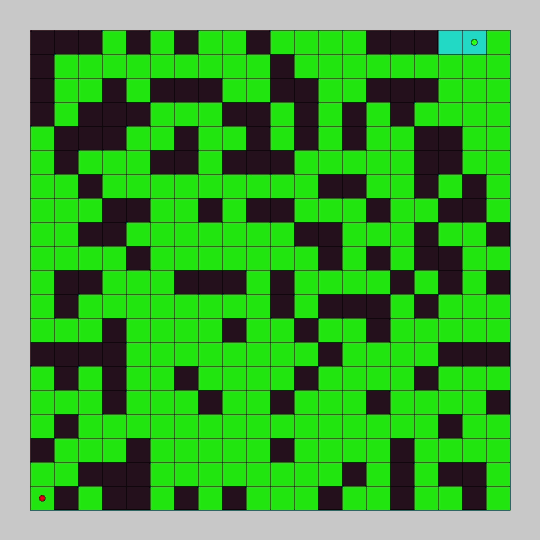
Learn how to explore a grid and find a goal point with breadth first search in this pathfinding tutorial. You will use Processing and Java to code the breadth first search pathfinding algorithm and create a graphical demo so you can see it in action.
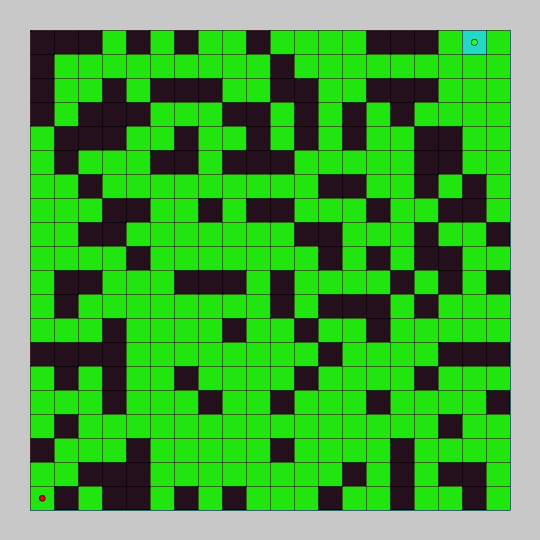
In the last tutorial, we programmed depth first search and watched it explore a node graph. In this tutorial we will program breadth first search and watch it explore a grid.
The breadth first search algorithm will add every unexplored adjacent node to a queue, and explore all of the added nodes in sequence. For each node explored, it will continue to add the adjacent unexplored nodes to the queue. It will continue to do this until the goal is found or all connected nodes have been explored.
#gamedev#indiedev#maze#pathfinding#game development#coding#creative coding#programming#Java#processing#search algorithm#tutorial#education#breadth first search#grid
18 notes
·
View notes
Text
Welcome to my blog!!
I'm @sunos-official, a blog to celebrate the wonders of the BSD (and later SVR4)-based Unix from Sun Microsystems in all of its iterations (although this blog will primarily focus on versions up to and including Solaris 9, with some appearances of Solaris 10).
I'll be working on populating the queue with fun Sun Microsystems-related goodness. In the mean time, enjoy some SunOS user interfaces!!

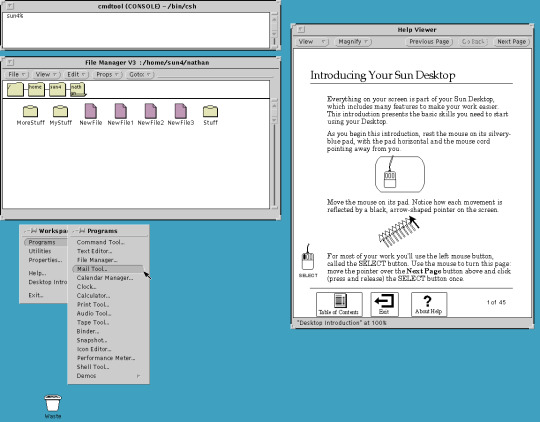
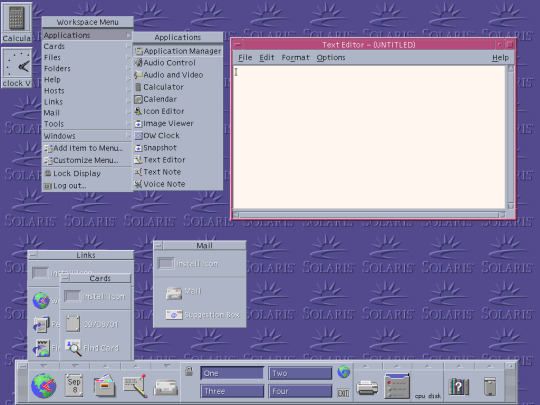
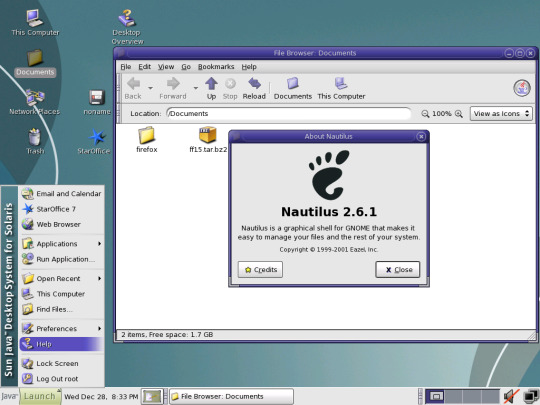
Pictured, clockwise from top left are:
SunView, SunOS 4
OpenWindows 3, SunOS 4
Common Desktop Environment, Solaris 8
Java Desktop System, Solaris 10
#unix#sun microsystems#retro computers#retro computing#old computers#operating system#solaris#sunos#vintage computer#sparc
30 notes
·
View notes
Text
Mastering Data Structures: A Comprehensive Course for Beginners
Data structures are one of the foundational concepts in computer science and software development. Mastering data structures is essential for anyone looking to pursue a career in programming, software engineering, or computer science. This article will explore the importance of a Data Structure Course, what it covers, and how it can help you excel in coding challenges and interviews.
1. What Is a Data Structure Course?
A Data Structure Course teaches students about the various ways data can be organized, stored, and manipulated efficiently. These structures are crucial for solving complex problems and optimizing the performance of applications. The course generally covers theoretical concepts along with practical applications using programming languages like C++, Java, or Python.
By the end of the course, students will gain proficiency in selecting the right data structure for different problem types, improving their problem-solving abilities.
2. Why Take a Data Structure Course?
Learning data structures is vital for both beginners and experienced developers. Here are some key reasons to enroll in a Data Structure Course:
a) Essential for Coding Interviews
Companies like Google, Amazon, and Facebook focus heavily on data structures in their coding interviews. A solid understanding of data structures is essential to pass these interviews successfully. Employers assess your problem-solving skills, and your knowledge of data structures can set you apart from other candidates.
b) Improves Problem-Solving Skills
With the right data structure knowledge, you can solve real-world problems more efficiently. A well-designed data structure leads to faster algorithms, which is critical when handling large datasets or working on performance-sensitive applications.
c) Boosts Programming Competency
A good grasp of data structures makes coding more intuitive. Whether you are developing an app, building a website, or working on software tools, understanding how to work with different data structures will help you write clean and efficient code.
3. Key Topics Covered in a Data Structure Course
A Data Structure Course typically spans a range of topics designed to teach students how to use and implement different structures. Below are some key topics you will encounter:
a) Arrays and Linked Lists
Arrays are one of the most basic data structures. A Data Structure Course will teach you how to use arrays for storing and accessing data in contiguous memory locations. Linked lists, on the other hand, involve nodes that hold data and pointers to the next node. Students will learn the differences, advantages, and disadvantages of both structures.
b) Stacks and Queues
Stacks and queues are fundamental data structures used to store and retrieve data in a specific order. A Data Structure Course will cover the LIFO (Last In, First Out) principle for stacks and FIFO (First In, First Out) for queues, explaining their use in various algorithms and applications like web browsers and task scheduling.
c) Trees and Graphs
Trees and graphs are hierarchical structures used in organizing data. A Data Structure Course teaches how trees, such as binary trees, binary search trees (BST), and AVL trees, are used in organizing hierarchical data. Graphs are important for representing relationships between entities, such as in social networks, and are used in algorithms like Dijkstra's and BFS/DFS.
d) Hashing
Hashing is a technique used to convert a given key into an index in an array. A Data Structure Course will cover hash tables, hash maps, and collision resolution techniques, which are crucial for fast data retrieval and manipulation.
e) Sorting and Searching Algorithms
Sorting and searching are essential operations for working with data. A Data Structure Course provides a detailed study of algorithms like quicksort, merge sort, and binary search. Understanding these algorithms and how they interact with data structures can help you optimize solutions to various problems.
4. Practical Benefits of Enrolling in a Data Structure Course
a) Hands-on Experience
A Data Structure Course typically includes plenty of coding exercises, allowing students to implement data structures and algorithms from scratch. This hands-on experience is invaluable when applying concepts to real-world problems.
b) Critical Thinking and Efficiency
Data structures are all about optimizing efficiency. By learning the most effective ways to store and manipulate data, students improve their critical thinking skills, which are essential in programming. Selecting the right data structure for a problem can drastically reduce time and space complexity.
c) Better Understanding of Memory Management
Understanding how data is stored and accessed in memory is crucial for writing efficient code. A Data Structure Course will help you gain insights into memory management, pointers, and references, which are important concepts, especially in languages like C and C++.
5. Best Programming Languages for Data Structure Courses
While many programming languages can be used to teach data structures, some are particularly well-suited due to their memory management capabilities and ease of implementation. Some popular programming languages used in Data Structure Courses include:
C++: Offers low-level memory management and is perfect for teaching data structures.
Java: Widely used for teaching object-oriented principles and offers a rich set of libraries for implementing data structures.
Python: Known for its simplicity and ease of use, Python is great for beginners, though it may not offer the same level of control over memory as C++.
6. How to Choose the Right Data Structure Course?
Selecting the right Data Structure Course depends on several factors such as your learning goals, background, and preferred learning style. Consider the following when choosing:
a) Course Content and Curriculum
Make sure the course covers the topics you are interested in and aligns with your learning objectives. A comprehensive Data Structure Course should provide a balance between theory and practical coding exercises.
b) Instructor Expertise
Look for courses taught by experienced instructors who have a solid background in computer science and software development.
c) Course Reviews and Ratings
Reviews and ratings from other students can provide valuable insights into the course’s quality and how well it prepares you for real-world applications.
7. Conclusion: Unlock Your Coding Potential with a Data Structure Course
In conclusion, a Data Structure Course is an essential investment for anyone serious about pursuing a career in software development or computer science. It equips you with the tools and skills to optimize your code, solve problems more efficiently, and excel in technical interviews. Whether you're a beginner or looking to strengthen your existing knowledge, a well-structured course can help you unlock your full coding potential.
By mastering data structures, you are not only preparing for interviews but also becoming a better programmer who can tackle complex challenges with ease.
3 notes
·
View notes
Text
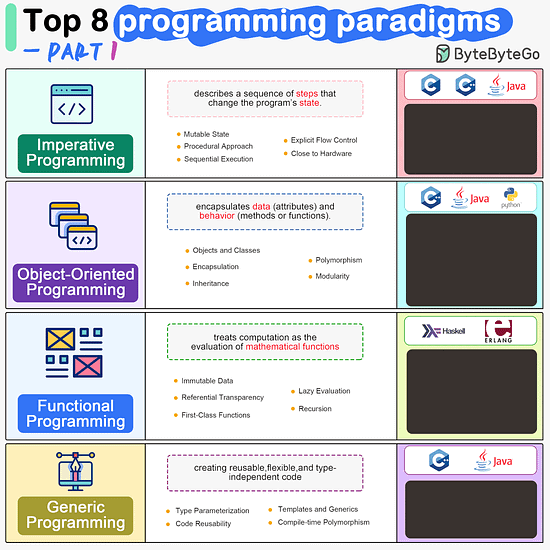
ByteByteGo | Newsletter/Blog
From the newsletter:
Imperative Programming Imperative programming describes a sequence of steps that change the program’s state. Languages like C, C++, Java, Python (to an extent), and many others support imperative programming styles.
Declarative Programming Declarative programming emphasizes expressing logic and functionalities without describing the control flow explicitly. Functional programming is a popular form of declarative programming.
Object-Oriented Programming (OOP) Object-oriented programming (OOP) revolves around the concept of objects, which encapsulate data (attributes) and behavior (methods or functions). Common object-oriented programming languages include Java, C++, Python, Ruby, and C#.
Aspect-Oriented Programming (AOP) Aspect-oriented programming (AOP) aims to modularize concerns that cut across multiple parts of a software system. AspectJ is one of the most well-known AOP frameworks that extends Java with AOP capabilities.
Functional Programming Functional Programming (FP) treats computation as the evaluation of mathematical functions and emphasizes the use of immutable data and declarative expressions. Languages like Haskell, Lisp, Erlang, and some features in languages like JavaScript, Python, and Scala support functional programming paradigms.
Reactive Programming Reactive Programming deals with asynchronous data streams and the propagation of changes. Event-driven applications, and streaming data processing applications benefit from reactive programming.
Generic Programming Generic Programming aims at creating reusable, flexible, and type-independent code by allowing algorithms and data structures to be written without specifying the types they will operate on. Generic programming is extensively used in libraries and frameworks to create data structures like lists, stacks, queues, and algorithms like sorting, searching.
Concurrent Programming Concurrent Programming deals with the execution of multiple tasks or processes simultaneously, improving performance and resource utilization. Concurrent programming is utilized in various applications, including multi-threaded servers, parallel processing, concurrent web servers, and high-performance computing.
#bytebytego#resource#programming#concurrent#generic#reactive#funtional#aspect#oriented#aop#fp#object#oop#declarative#imperative
8 notes
·
View notes
Text
youtube
Data Structure and Algorithms in JAVA | Full Course on Data Structure
In this course, we are going to discuss Data Structures and Algorithms using Java Programming. The data structure is a way to store and organize data so that it can be used efficiently. It is a set of concepts that we can use in any programming language to structure the data in the memory. Data structures are widely used in almost every aspect of computer science i.e. operating systems, computer science, compiler design, Artificial Intelligence, graphic,s and many more. Some examples of Data structures that we are going to cover in this course are arrays, linked lists, stack, queue, Binary Tree, Binary Search Tree, Graphs, etc. Apart from knowing these data structures, it's also important to understand the algorithmic analysis of a given code. Different Sorting and searching techniques will be talked about with their implementation in java programming. Lastly, this course contains information on the Greedy approach, Dynamic approach, and divide and Conquer approach to programming.
#youtube#free education#education#educate yourselves#technology#educate yourself#data structures#data analytics#Data Structure and Algorithms in JAVA#javaprogramming#Data Structure and Algorithms#how to think like a programmer#programming classes#programming
3 notes
·
View notes
Text
Software Technical Interview Review List
Data Structures
Arrays (and Java List vs ArrayList)
String
Stack
Queue
LinkedList
Algorithms
Sorting (Bubblesort, Mergesort, Quicksort)
Recursion & Backtracking
Linear and Binary Search
String/Array algos
Tree traversal
Dynamic Programming
Graph algos (DFS, BFS, Dijksta's and Kruskals)
OOP fundamentals
Polymorphism
Inheritance
Encapsulation
Data abstraction
SOLID and GRASP
Explanations & example questions:
Strings and Arrays [ 1 | 2 | 3 | 4 | 5 | 6 | 7 | 8 ]
Stacks and Queues [ 1 | 2 ]
LinkedList [ 1 | 2 ]
Sorting & searching [ 1 | 2 | 3 | 4 | 5 | 6 | 7 ]
Recursion and Backtracking [ 1 | 2 | 3 | 4 ]
Dynamic Programming [ 1 | 2 | 3 | 4]
Graphs [ 1 | 2 | 3 ]
Tree [ 1 | 2 ]
General DS&A info and questions [ 1 | 2 | 3 | 4 | 5 ]
OOP review & questions [ 1 | 2 | 3 ]
#ive been procrastinating this coding assessment for my interview so bad 😭😭#im just scared of messing up cause i need this internship#But its due soon so im really buckling down now >:)#object oriented programming#algorithms#data structures#software engineering#ref#resource#mypost
20 notes
·
View notes
Text


sensory
#mine#stim#asmr#heartcore#lovecore#slime#thick slime#red#white#blue#poking#java chip slime#hands //#trypophobia //#queue are my sunshine
20 notes
·
View notes
Text
How to Prepare for a Coding Interview
Coding interviews are a crucial part of the tech hiring process. As a candidate, you'll need to showcase your technical skills, problem-solving abilities, and understanding of data structures and algorithms. To succeed, it's essential to be well-prepared. In this article, we'll discuss the steps you can take to prepare effectively and increase your chances of getting hired.
Understanding the Coding Interview Process
Before diving into the preparation, it's important to understand the coding interview process.
These interviews are not just about writing code; they also test your ability to think critically under pressure and explain your reasoning behind the solutions you propose. Interviewers are interested in understanding your approach to problem solving and how you handle challenges in a real-time setting.
The Role of Coding Interviews in Tech Hiring for Candidates
By evaluating your coding abilities, interviewers can determine if you're the right fit for the job and the company culture. However, it's not just a one-sided test. It's also an opportunity for the candidate to learn more about the company and its work environment.
Developers will only be successful in a role if the environment is one that is conducive to how they like to work, collaborate, and engage. It’s a win-win benefit for both candidates and employers if both sides are equally excited at the prospect of working together.
Different Types of Coding Interviews
Coding interviews can vary in format and structure. Some companies may conduct coding interviews in-person, while others prefer remote interviews. Additionally, coding interviews can be divided into different types, such as whiteboard coding exercises, take-home assignments, or pair programming sessions.
Each type of coding interview has its own unique challenges and requirements. Whiteboard coding exercises, for example, test your ability to write code on a whiteboard while explaining your thought process out loud. Take-home assignments, on the other hand, give you the opportunity to work on a coding problem at your own pace and showcase your problem-solving skills in a more relaxed environment. Pair programming sessions involve collaborating with an interviewer to solve a problem together, demonstrating your ability to work effectively in a team setting.
Essential Skills for Coding Interviews
Preparing for a coding interview requires mastering several essential skills. Let's explore these skills in detail.
Programming Languages to Master
Individuals should be proficient in at least one programming language commonly used in the industry, such as Python, Java, C++, or JavaScript. Understanding the syntax, data types, control structures, and libraries of your chosen language will help you solve coding problems efficiently.
Problem-Solving Skills
Problem-solving skills are an integral part of a coding interview. Being able to approach a problem strategically, break it down into smaller subproblems, and devise an efficient solution is highly valued. Practice solving coding challenges and algorithms to sharpen your problem-solving abilities.
Understanding Data Structures and Algorithms
Data structures and algorithms are the building blocks of computer science. Familiarize yourself with various data structures like arrays, linked lists, stacks, queues, trees, and graphs. Additionally, learn popular algorithms for searching, sorting, and optimization. Understanding these concepts will help you analyze problems and devise optimal solutions.
Pre-Interview Preparation
Embarking on the journey of pre-interview preparation is akin to laying the foundation for a successful career in the tech industry. The diligence and effort you put into honing your skills now will pave the way for future opportunities and growth. Here are a few steps you should take before the interview.
Review Common Coding Questions
Start by researching and reviewing common coding questions asked in interviews. Online platforms like LeetCode or HackerRank offer a vast collection of coding problems categorized by difficulty levels. Spend time solving these problems to familiarize yourself with the question patterns and potential solutions.
Practice on Coding Platforms
Practicing on coding platforms simulates the interview environment and helps improve your coding skills. These platforms often offer interactive coding challenges, enabling you to practice solving problems under time constraints. Engage in coding competitions or take part in mock interviews to get a real feel for the interview process.
Brush Up on Technical Knowledge
Aside from coding skills, brush up on your technical knowledge. Review key concepts related to your preferred programming language, data structures, algorithms, and system design. Understanding these concepts in-depth will help you during technical discussions and coding challenges.
During the Interview
Now let's focus on what to do during the coding interview to maximize your chances of getting hired.
When you enter the interview room, remember that your body language and demeanor also play a significant role in making a positive impression. A firm handshake, good posture, and maintaining eye contact can convey confidence and professionalism. These non-verbal cues can complement your technical skills and create a well-rounded image for the interviewer.
Effective Communication During Coding Interviews
During the interview, effective communication is crucial. Clearly explain your thought process, rationale, and any assumptions you make while solving a problem. Communicating effectively helps the interviewer understand your approach and evaluate your problem-solving abilities.
Moreover, active listening is equally important during coding interviews. Pay close attention to the interviewer's prompts and questions. This demonstrates your ability to process information in real time and adapt your problem-solving strategy accordingly. Engaging in a dialogue rather than a monologue can showcase your collaborative skills and willingness to take feedback.
Demonstrating Your Thought Process
Interviewers are interested in how you approach problems and arrive at solutions, rather than just the end result. Be vocal about your thought process throughout the interview. Explain the steps you're taking, potential optimizations or trade-offs, and any ideas that come to mind. This demonstrates your ability to analyze problems and think critically.
Also, don't hesitate to ask clarifying questions if you encounter ambiguity in the problem statement. Seeking clarification shows your attention to detail and ensures that you and the interviewer are on the same page. It's better to take a moment to clarify the problem than to proceed with a misunderstanding that could lead you down the wrong path.
Handling Unknown Problems
Not all problems presented in coding interviews are familiar or straightforward. Interviewers often assess candidates' ability to handle unknown problems and think on their feet. When faced with unfamiliar problems, stay calm and logical. Break down the problem, identify patterns or similarities to other problems you've solved, and come up with a step-by-step approach.
Remember, the interviewer is not just evaluating your technical skills but also your problem-solving methodology. Demonstrating resilience in the face of uncertainty and showcasing adaptability can leave a lasting impression. Embrace the challenge of unknown problems as an opportunity to showcase your creativity and resourcefulness in problem solving.
In Conclusion
Preparing for a coding interview requires a combination of technical skills, problem-solving abilities, and effective communication. Understanding the coding interview process, mastering essential skills, and thorough preparation will increase your chances of getting hired. Remember, practice makes perfect, so devote enough time to solving coding problems, reviewing concepts, and gaining confidence.
3 notes
·
View notes
Text



🤍 | J4 Slime
#mod 🍃#stim#sfw#sfw blog#toycore#slime#thick slime#java chip slime#poking#white#red#blue#stretching#hands //#trypophobia //#queue tie pie#all caps //
1 note
·
View note
Text
Anyways, time for an introductionary post!
Welcome to Will It Trim?, the hottest new show on the block! Here we used some dubious methods to get every single thing to be able to become an armour trim, and now I'm posting them!
Wait, who are you?
Who am I? It's none other than @blueengland! Here to share cool (or dull) armour trims you can get if you become an affront to god!
How are you doing this?
It's a mod called All The Trims which lets you turn literally any item into an armour trim! It's dynamic, meaning you won't get thousands of textures and slow your game down, and it also works with modded items! You can use anything as an armour trim, even armour trim templates!
What does [x item] look like as a trim?
If you want to find out but don't have minecraft java simply send me an ask! This blog (mostly) runs on a queue so keep your eyes open!
2 notes
·
View notes
Text
"Fuck, fuck, fuck.” Mia shouted angrily, grabbing some clothing she found laying on the floor. She couldn’t be fussy this morning, she had to wear whatever she just picked up - after all, she was running late for work. The brown haired woman couldn’t exactly be late for work either as she had to hand over her presentation to her boss before the children came in. Mia questioned why she wanted to work as a teacher when all she truly wanted in that moment in time was more sleep. “Coffee.” She blurted out to herself, shrugging on her backpack. The brunette looked in the mirror, she really looked like a school kid. She was wearing a jumper, leggings, boots and a backpack with her hair tied in a bun. Mia always worried the children wouldn’t take her seriously if they had her in class and she felt as though her attire wasn’t helping her case either. Mia ran out the door, locking her apartment after her.
Mia was currently on one mission - get coffee. The short woman ran down the streets, trying her best to make it in time for coffee and work - she couldn’t do her job this tired after all. The brunette wasn’t usually one for coffee either, she was truly a tea lover through and through. Although, she did know when she was needing it - it just meant that she would be up all night marking papers before crashing hard. “Coffee, coffee, coffee.” The girl murmured, looking up at the shop that stood before her - Java Junction. She sped in, not realising she had jumped the queue. “Can I get a triple-shot espresso iced coffee please?” She asked the server, pulling out her phone from her bag to pay. The brunette looked up at the server with a puzzled face before turning round to the person before her who was also about to pay for their items. “Oh my God, I am so sorry.” She blurted out, looking the person up and down. “I just jumped didn’t I? I’m like the worst person ever. Please let me buy you your stuff.”

2 notes
·
View notes